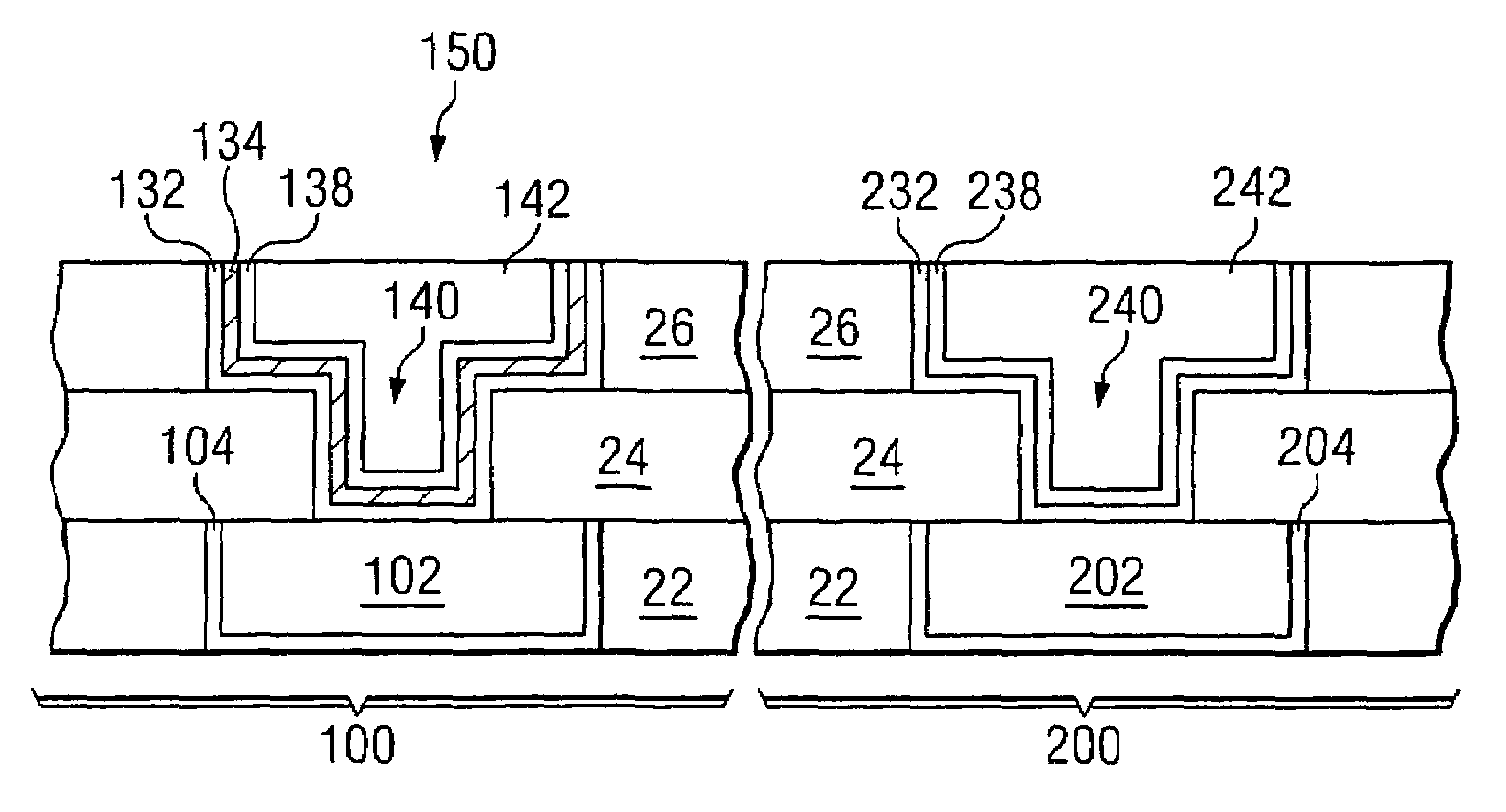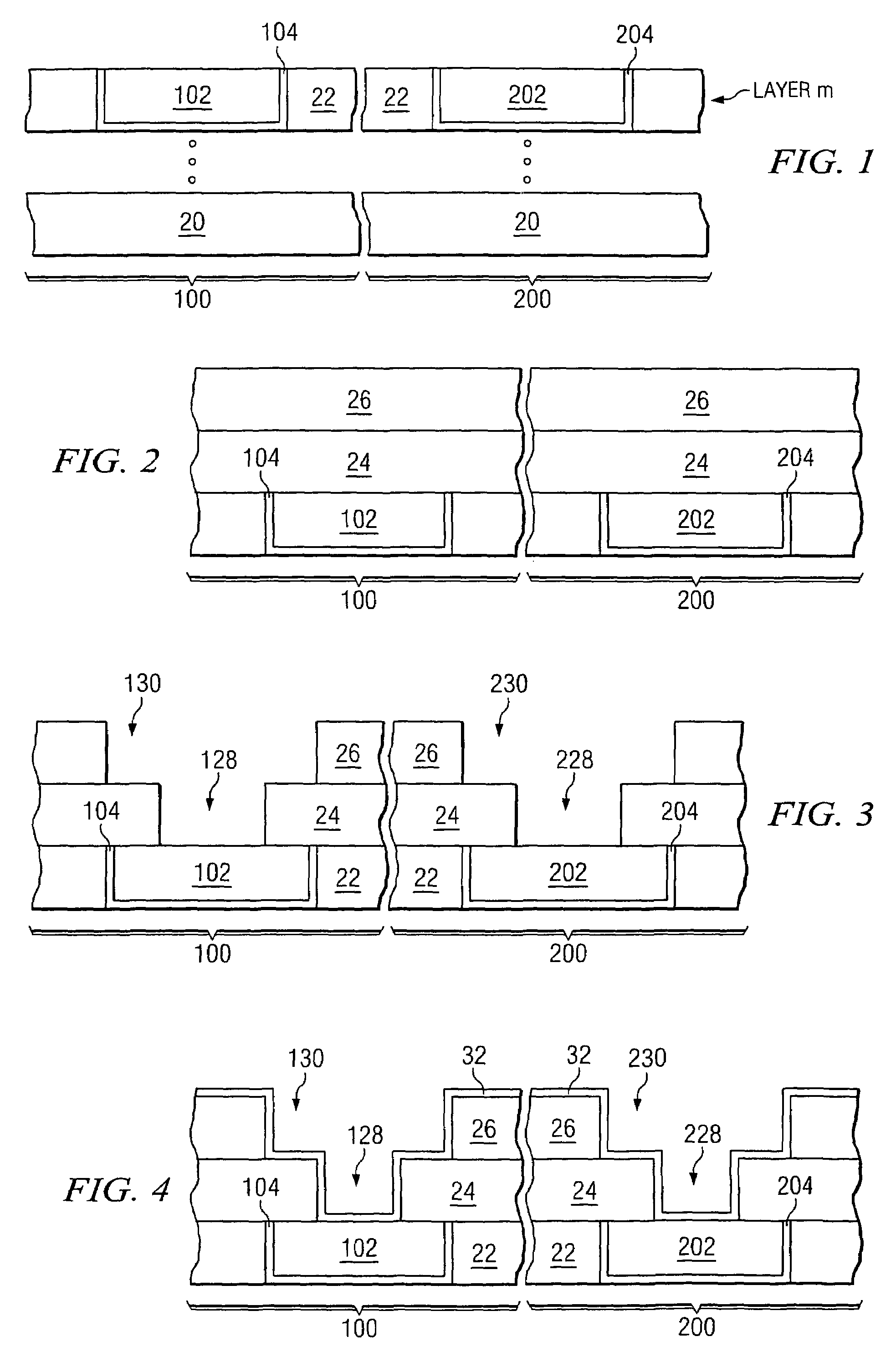One-time-programmable anti-fuse formed using damascene process
a damascene process and one-time-programmable technology, applied in the direction of semiconductor devices, semiconductor/solid-state device details, electrical apparatus, etc., can solve the problems of increasing complexity and cost, increasing complexity and cost of fabricating integrated circuits, and not being compatible with current copper damascene processes. achieve the effect of reducing write voltag
- Summary
- Abstract
- Description
- Claims
- Application Information
AI Technical Summary
Benefits of technology
Problems solved by technology
Method used
Image
Examples
first embodiment
[0025]In a first embodiment, an OTP anti-fuse cell, which has a via-like structure, is formed simultaneously with a via structure. Both the OTP anti-fuse and the via structure comprise lower-level metal lines and upper-level metal lines interconnected by vias. FIG. 1 illustrates two regions 100 and 200 over a semiconductor substrate 20, which have devices (not shown) formed thereon. Region 100 is used for forming an OTP anti-fuse cell, and region 200 is used for forming a via. FIG. 1 also illustrates a metallization layer m over the semiconductor substrate 20, wherein metallization layer m includes a dielectric layer 22, a lower-level metal feature 102 in region 100 and a lower-level metal feature 202 in region 200. Metallization layer m may be any of the metallization layers except the top metallization layer. Dielectric layer 22 preferably comprises a material having a dielectric constant (k value) of less than 3.9, and may contain nitrogen, carbon, hydrogen, oxygen, fluorine, and...
second embodiment
[0041]In a second embodiment, an OTP anti-fuse having a crown-type MIM capacitor structure is formed. Referring to FIG. 10, a semiconductor substrate 310 is provided with an insulation layer 314 formed thereon. A metal line 316, for example, a copper line 316, is formed over insulation layer 314, followed by the deposition of an inter-metal dielectric (IMD) layer 320 over metal line 316. A damascene opening 312 is etched through IMD layer 320, exposing metal line 316.
[0042]Referring to FIG. 11, a first diffusion barrier layer 322 is deposited conformally within the damascene opening 312 and on IMD layer 320. First diffusion barrier layer 322 may comprise titanium nitride, tantalum nitride, titanium silicon nitride, and / or tantalum silicon nitride. A first copper layer 324 is formed over first diffusion barrier layer 322, for example, by electroplating or electroless plating. The copper is formed on the bottom and sidewalls of the damascene opening. First copper layer 324 will form a...
third embodiment
[0046]In the present invention, an OTP anti-fuse having a planar MIM structure, as is shown in FIG. 13, is formed. The planar anti-fuse includes a top plate 412, a bottom plate 414 and an insulation layer 410 therebetween. Bottom plate 414 is preferably bigger than top plate 412. Contact plugs 416 and 418 connect to the bottom plate 414 and top plate 412, respectively. Each of the top and bottom plates 412 and 414 may further include diffusion barrier layers. One skilled in the art will realize the respective formation steps.
PUM
 Login to View More
Login to View More Abstract
Description
Claims
Application Information
 Login to View More
Login to View More - R&D
- Intellectual Property
- Life Sciences
- Materials
- Tech Scout
- Unparalleled Data Quality
- Higher Quality Content
- 60% Fewer Hallucinations
Browse by: Latest US Patents, China's latest patents, Technical Efficacy Thesaurus, Application Domain, Technology Topic, Popular Technical Reports.
© 2025 PatSnap. All rights reserved.Legal|Privacy policy|Modern Slavery Act Transparency Statement|Sitemap|About US| Contact US: help@patsnap.com



